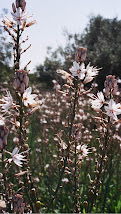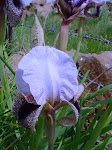Anemones come in many colours beside red

- here are some beautiful lilac ones
Tuvia's iris
Beautiful
The rarest of irises
In the last few weeks I have had the good fortune to visit both the Golan and the Negev. In both places, surprisingly enough, I saw wild irises in bloom.
In 1948 the ill-fated Lamed Hey were ambushed in the Ela valley as they tried to come to the aid of the besieged defenders of Gush Etzion. One of the 35 young heroes who gave his life that day was Tuvia Kushnir.
All his too short life he was a lover of flowers and had gone on many a field trip seeking them out. On one such trip, he wandered into Jordan and was arrested by the Jordanians, as they thought he was a spy. Who would believe that an Israeli would stray into Jordan looking for a flower? But they did, and he was released unharmed.
Tuvia discovered an iris that at first was thought to be the Irus Eretzisraeli or Iris palaestina but it turned out to be a much rarer relative, unique to Israel. This beautiful and rare flower is found in the wilds of the Negev desert north of Mitzpeh Ramon.
To my immense joy, I found and photographed one at Borot Lotz, not far from a desert cystern dug three thousand years ago by the Children of Israel.
The swamp iris

What an intricate flower the Grant Duff's iris is.
Egg yolks

Lovingly encircled
Saturday, September 12, 2009
Autumn is officially here!
The white squill says so! This majestic plant is everywhere! By the sea, in the hills and as can be seen in my picture, in Tel Aviv. Those speeding down the Namir Road may not be aware of it but the squill is merrily flowering behind the shrubbery that lines the road.
Actually summer seems reluctant to let go as temperatures which had dropped to a pleasant 28 soared again yesterday to the upper 30s, but we are getting there.
Interestingly in Bible times there were only two seasons, summer and winter. Guess when you are a farmer that is all you are interested in.
Urginia maritima, the sea squill, is known in Hebrew as Chatzav (ch as in Loch). The root of the word means hewing, or digging down through rock. The word for a quarry is machtzavah.
While today we just enjoy the sight of this stately flower, in olden days the squill had a more pragmatic function. Clearing a field for agricultural purposes was always a difficult task. Rocks and unwanted indigenous plants would have to be combatted.
Not surprisingly in a land where water is a precious commodity, the rains falling briefly and unreliably only in the winter period means that for plants to survive they have to put their roots deep into the earth, or develop some other survival techniques. The squill goes deeper than many. When digging it out, if any part of the bulb is left it regenerates.
Thus, when the squill made its end of summer appearance it would clearly delineate the borders of the cultivated fields. Obviously no farmer could sneakily plant a row of these stately plants in an attempt to enlarge his portion! By the way, there is a clear edict in the Bible forbidding tampering with your neighbour’s boundaries (Deuteronomy 19:14) so clearly this is not only a modern problem.
The toxic compounds in the squill can cause blistering of the skin after handling the plant. This effect would certainly discourage malicious individuals from uprooting the plant to obscure property lines. However, with forward planning it could be planted for future use as a border. Presumably by someone wearing gloves.
The Talmud (Baba Batra 55a) describes this as a common practice, and states that Joshua planted it to delineate the borders of the tribes of Israel after the apportionment of the land (Baba Batra 56a).
Pity they didn’t use it instead of the Green Line (made by a green crayon on a crude map) in 1948! Could have saved us a lot of heart-ache.
Actually summer seems reluctant to let go as temperatures which had dropped to a pleasant 28 soared again yesterday to the upper 30s, but we are getting there.
Interestingly in Bible times there were only two seasons, summer and winter. Guess when you are a farmer that is all you are interested in.
Urginia maritima, the sea squill, is known in Hebrew as Chatzav (ch as in Loch). The root of the word means hewing, or digging down through rock. The word for a quarry is machtzavah.
While today we just enjoy the sight of this stately flower, in olden days the squill had a more pragmatic function. Clearing a field for agricultural purposes was always a difficult task. Rocks and unwanted indigenous plants would have to be combatted.
Not surprisingly in a land where water is a precious commodity, the rains falling briefly and unreliably only in the winter period means that for plants to survive they have to put their roots deep into the earth, or develop some other survival techniques. The squill goes deeper than many. When digging it out, if any part of the bulb is left it regenerates.
Thus, when the squill made its end of summer appearance it would clearly delineate the borders of the cultivated fields. Obviously no farmer could sneakily plant a row of these stately plants in an attempt to enlarge his portion! By the way, there is a clear edict in the Bible forbidding tampering with your neighbour’s boundaries (Deuteronomy 19:14) so clearly this is not only a modern problem.
The toxic compounds in the squill can cause blistering of the skin after handling the plant. This effect would certainly discourage malicious individuals from uprooting the plant to obscure property lines. However, with forward planning it could be planted for future use as a border. Presumably by someone wearing gloves.
The Talmud (Baba Batra 55a) describes this as a common practice, and states that Joshua planted it to delineate the borders of the tribes of Israel after the apportionment of the land (Baba Batra 56a).
Pity they didn’t use it instead of the Green Line (made by a green crayon on a crude map) in 1948! Could have saved us a lot of heart-ache.
Subscribe to:
Comments (Atom)
The glorious Poleg irises

This area of the Netanya cliffs is slated to disappear beneath a housing development. But the area alongside will be saved. And willing volunteers are lovingly digging up and replanting the iris rhizomes in the protected place.



















